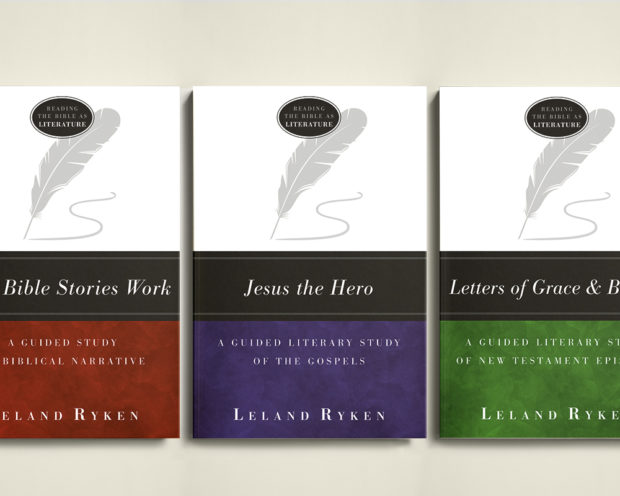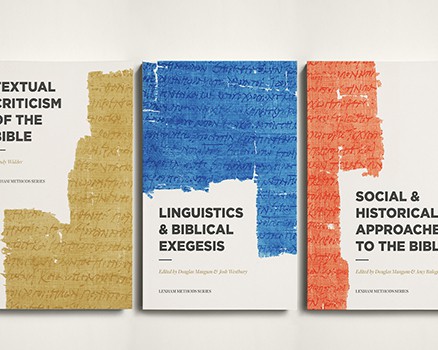Exegesis is the most comprehensive form of Bible study. It gathers together nearly every Bible study task—word studies, translation comparison, research, and more—for a thorough examination of a biblical passage.
While there is no singular process of exegesis, there is a general progression most follow. This page will introduce you to it.
When it comes to an exegetical paper, you are revealing only the highlights of your process (or whatever your professor asks you to report). This article will focus primarily on the exegetical process, ending with a section on how to present your findings in a paper. This guide assumes you’ve been assigned a particular passage. If you haven’t, choose a passage that interests you or presents well-known interpretive challenges (such as Heb 5:11–6:12).
Survey the Passage
The first step is to get familiar with the passage—simple reading and initial observation. Try the following to make your reading more productive:
- Read your passage several times in your preferred translation. As you read, highlight and mark the text—anything that stands out to you. This may include repeated or important theological words, key ideas, noteworthy people or places, and more.
- Ask questions about the text. What confuses you? What surprises you? What does it seem to say on the surface?
- Read your passage in multiple other translations. Now that you’ve familiarized yourself with the text, get more takes on it. If you know Greek or Hebrew, read the passage in the original language, too.
Explore Context and Genre
People love to skip this next part—at their own peril. They’ve just come from reading their passage, and they’re eager to chase down answers to their questions. But if they go without context and genre, they’ll go in the wrong direction!
Here you are establishing some basic parameters for interpreting your text.
- Literary context. There are concentric circles of literary context to consider. Those closest to your text have the weightiest bearing on its meaning. From near to far they are:
- Surrounding verses. What are the units of thought on both sides of your passage about? That will help you understand how your verses contribute to the narrative or flow of thought. Think of it like doing a puzzle: when you know what the surrounding pieces of your piece look like, you know better how to place it.
- Book. Continuing our puzzle metaphor, what is the whole puzzle of? Knowing the general message and aim of a book will help you clarify what your passage is about (and is not about). For example, 1 and 2 Timothy are Paul’s instructions to a young pastor, not to all Christians necessarily. So that gives you more clarity about the meaning of each passage.
- Whole Bible. Finally, every book of the Bible contributes something to the whole. This may not have a strong bearing on your particular passage, but it is helpful. For example, when studying an Old Testament passage, keep in mind that the original audience (the Jews) didn’t have the revelation of Jesus Christ. So first ask, “What would this have meant to them at *this* point in history?” That said, the Old Testament is Christian Scripture (Luke 24:23), so it is appropriate to interpret the Old Testament through the lens of Christ but only after you consider its original meaning. So it’s both, never one without the other.
- Cultural-historical context. The Bible, like any book, is a product of its time. Knowing the culture and history surrounding your passage is important for understanding it. Usually commentaries will acknowledge pertinent cultural-historical context, but you may need to turn to Bible dictionaries and other resources for more information.
- Genre. Genre is like context in that it creates boundaries for interpreting your text. That’s because every genre has its own rules of interpretation. Poetry and apocalyptic literature are heavy with imagery, a component of figurative language. Those images are key to unlocking meaning. Whereas the genre of epistle, or letter, is straight forward. It follows the constructs of rhetoric, so the logical relationships between clauses are handholds for accessing meaning. Responsible Bible readers know the genre they are working with and how the rules of that genre carry and clarify meaning.
Resources for Scripture study

Reading the Bible as Literature Series
This six-volume series by Leland Ryken is a one-stop shop for a lifetime of better Bible reading through knowledge of genre. Learn the rules of interpreting literature to better interpret the Bible.
Literary Styles in the Bible
This introduction to genre by The Bible Project is helpful for a simple grasp on the different literary styles found in Scripture.
Explore the rest of this series
Analyze the Text
Here we get to the true heart of biblical exegesis: textual analysis. Here you are dissecting the text, turning over every rock to discover what it communicates.
- Parse words. The building blocks of meaning, each word is important. You may not need to parse *every* word, but you should identify parts of speech at least so you see how each sentence holds together. You’ll be able to intuit what words (verbs especially) are necessary to parse.
- Identify important relationships. After you’ve parsed the words, you can move on to examining how they relate to each other. How are clauses connecting? How does one sentence lead to the next? Examine the joints of the passage to see how it holds together. Again, genre will determine the relationships to watch for. In rhetoric, the relationships are logical (“therefore, ” etc.), whereas in poetry, parallelism is a more common relationship.
- Outline the whole passage. By now you have a clear sense for the flow, so zoom out and try to summarize that flow. What seems to be the author’s intended way of structuring the text? Genre will instruct you somewhat here, and you’ll spend your whole life refining your instincts for spotting structure. But generally, ask, “What is the organizing element of my passage?” For rhetoric, it could be a series of “therefore’s,” for a Gospel pericope, it could be a series of parables or healings. Or it could be neither. As you examine the text, seek out patterns, which usually reveal structure.
- Study important words. By this time, you’re familiar with the text to know which words are the most critical. For example, theological words like “propitiation” or “covenant” are big ones. Likewise, repeated words are worthy of your attention. Trust your instincts to follow you to the words worth digging into especially.
- Examine cross-references. Because the Bible speaks with a unified voice, it’s helpful to consult related passages. Sometimes that’s a parallel passage, one that nearly mirrors your own (e.g. Rom 12:2 and Col 3:1–2). It could also be a reference or allusion, like when Hebrews 3 quotes from Psalm 95. Follow the connections around the Bible for more clarity, since Scripture interprets Scripture.
- Note your questions. The last step in the process, determine what you still need to iron out. These are the questions you can look for as you study commentaries (the next part of the process). Try your best to come up with a provisional answer to each question, so that you come to the commentaries with an informed opinion.
Resources for textual analysis

Biblical Exegesis Bundle
Take two digital courses in Old and New Testament Exegesis for a truly thorough understanding of the interprative process for both testaments. These will introduce you to the essentles of genre, context, textual analysis, and more.

Lexham Methods Series (4 vols.)
The Lexham Methods Series is designed for exegetes who need to learn, refresh, and master the tools of biblical scholarship. The books present scholarly information in an easy-to-understand format and focus on cutting-edge methods for biblical interpretation while avoiding jargon. The four volumes give you a complete overview of every major type of biblical interpretation, featuring history and key figures, methods and terms, and a how-to section, giving you a strong foundation for further research.
Look at the Book
One of the best ways to learn to analyze and interpret Scripture is to learn from people who’ve been doing it for you. This resource from Desiring God takes you into John Piper’s study process in a quick, accessible way. Watch even three of these, and you’ll learn some of the most basic, critical steps for analyzing a text.
Interpret the Passage
This emerges quite naturally from the previous step, and yet it’s a distinct step.
Above, you are asking, “What do I see?” Here, you are asking, “What does it mean?” Try just writing out your answer. “In this passage, [author] says…” and explain it as if you were summarizing the passage to a friend. To truly synthesize your work, try to put it down in one sentence, too. For example, you might summarize Colossians 3:1–17 as, “Since we’ve been raised to new life with Christ, we must put away the old way of living and put on the new.”
You want to walk into your commentary research having your own take on what the passage means, so don’t skip this process. But also recognize this is a provisional interpretation.
Tip: Try to summarize the passage such that someone who knows the Bible very well would say, “Ah, that’s a summary of [insert passage].” For example, in the example above, I used the language of Colossians 3:1–17 to summarize it. As a professor once told me, “Try and say it in a way that could only describe your passage, and no other.”
Consult Commentaries
This is where you bring your work before other scholars as if to say, “Here’s what I see. What do you see?”
Consult is the word. You are an interpreter, too, so you’re not farming out the process to scholars. But, recognizing they’ve spent literally years studying Scripture, their insights are invaluable. Here are some tips for using commentaries effectively:
- Don’t read every page. While you may choose one commentary to read all the way through on your passage, you don’t necessarily need to research every verse.
- Focus on your questions. Instead, go to the parts of the commentary tha speak to your questions. There will likely be insights you hadn’t thought of or couldn’t have known.
- Read multiple commentaries. You should never rely on the insights of one scholar. Instead, consult several for multiple perspectives.
- Know your commentaries. Not all commentaries are created equal or serve the same purpose. If your question is a textual one, consult a critical commentary. If it’s a pastoral one, an expository commentary is more suited. If it’s theological, reach for a theological commentary. Commentaries will give extended treatment on various parts of interpretive process.
- Logos Blog: 3 Rules for Using Commentaries
- Logos Blog: How to Use a Critical Commentary If You’re an Evangelical
- Logos Blog: Can a Good Commentary Really Improve Your Bible Study?
Resources for choosing commentaries
In addition to the blogs above (especially the first and third listed), these resources will help you choose and use commentaries wisely.

Old Testament Commentary Survey, 5th ed.
This commentary survey from Tremper Longman III reviews the most widely known and published commentaries on the Old Testament.

New Testament Commentary Survey, 7th ed.
In the same vein as the Longman’s Old Testament Commentary Survey, D. A. Carson wrote a companion volume for New Testament commentaries.
Bestcommentaries.com
This site has aggregated reviews on thousands of commentaries to come up with a well-regarded list of the top commentaries for every book of the Bible.
Denver Seminary recommendations
These bibliographies from Denver Seminary categorize their recommendations by different types of commentaries.
Refine Your Interpretation
Now that you’ve cast new light on your interpretation, refine it. You likely had some questions answered and assumptions corrected. Note those changes, because they are probably going to be the most interesting parts of your paper.
Reflect Theologically
So far, we’ve been squarely in the realm of textual interpretation. A big part of interpreting a text properly, though, is doing theological reflection—asking questions like:
- What are the theological themes of my text?
- What broader theological themes or topics does mine relate to? What does it contribute to them?
- What are opposing theological positions to my interpretation? What are their merits and deficincies?
- What is the history of this topic? (For example, if the Trinity is a subject of your text, you might research some of the debates of the early Church on the doctrine of the Trinity. Or if it’s about justification, brush up on the Reformation.)
- What are the implications of this theology? In other words, if this is true, what else is true?
For all of these, commentaries and theological dictionaries can be helpful for you. Typically you can find a “Theology” section in a commentary that speaks to these questions.
- Logos Blog: Make Sure to Include Systematic Theology in Your Bible Exposition
- Kevin DeYoung, The Gospel Coalition: Systematic Theology Review
Resources for theological reflection
Every good Bible reader needs to have an arsenal of theological resources, especially systematic theologies. There are hosts of systematic theologies, which is why our first recommendation is the Theology Guide in Logos.
Logos Theology Guide
The Theology Guide collects and displays key information related to all the major topics in systematic theology. It provides a brief introduction to each topic and links directly to systematic theologies in Logos.
Explore the Theology Guide in Logos
Ranked systematic theologies
This impartial list from Bestcommentaries.com ranks systematic theologies by popularity, providing a wonderful introduction to the best systematic theologies. Tip: Purchase these in Logos.com so that they are linked with all your Logos tools for more seamless and thorough study.
Browse the systematic theologies ranking
Write Your Paper
You’ve studied, reflected, researched, and reflected more—now it’s time to bring it all together.
Your paper should follow whatever parameters your professor sets out, so the below advice may not be relevant for you.
At any rate, here are a few pointers.
- Read this guide. It will walk you through the basics of writing a solid research paper. You can skip whatever portions aren’t relevant to you.Specifically, you should be sure to read the parts about:
- Deciding a thesis
- Outlining your paper
- Writing well
- Citing your sources
- Report the highlights. If you did your homework, you learned way more than you should tell in your paper. Focus on the highlights. Summarize context, genre, and structure pretty quickly so you can get to the meat: the interpretive challenges you faced, what you thought initially, and what changed your mind.
- Show that you know the big issues of the text. This is related to the above in that it focuses on the interpretive challenges of the text. If you were thorough in your commentary research, you know the big disagreements, the strengths and weaknesses of each position, and why you take the position you do.
How to write a good paper
Here are three resources to help you write well on any topic, but especially the Bible and theology.
Tyndale Seminary: How to Write an Effective Paper
This is a mercifully short yet comprehensive guide, and it’s organized well. Consider it a crash course in the most important rules of theological writing.
John Frame: How to Write a Theological Paper
This short post by John Frame (adapted from a book) is more about the heart of a good paper than about the mechanics. Paired with the above article, you are nearly all set.
Elements of Style
This is a short, punchy, classic work about writing. It mainly covers grammar and style—from the right way to use commas to how not to be boring. If you ever write anything, you should read this book.
Behold Your Paper
That’s a wrap! If you follow these steps, you’ll have thoroughly examined a passage, invited the history of its interpretation into your own work, and reported your findings well to other. Now repeat for other texts to become an even better student and teacher of the Bible.






